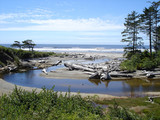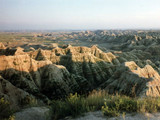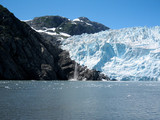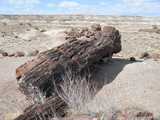Government Grants
Business Grants
Home Owner Programs
Federal Programs
About Us
Effects of Infanticide Risk on Brown Bear Resource Selection in Lake Clark National Park and Preserve, Alaska
NOTICE OF INTENT TO AWARD This Funding Announcement is not a request for applications.
This announcement is to provide public notice of the National Park Service (NPS), intention to fund the following project activities without competition.
ABSTRACT Funding Announcement
P15AS01024 Project Title Effects of Infanticide Risk on Brown Bear Resource Selection in Lake Clark National Park and Preserve, Alaska Recipient Mississippi State University Principle Investigator / Program Manager Jerrold Belant Total Anticipated Award Amount $65,735 Cost Share None New Award or Continuation? New Anticipated Length of Agreement 2. 5 Years Anticipated Period of Performance 8/30/15 – 12/30/2017 Award Instrument Cooperative Agreement Statutory Authority 54USC§100702 Cooperative Studies Units:
The Secretary shall enter into cooperative agreements with colleges and universities, including land grant schools, in partnership with other Federal and State agencies, to establish cooperative study units to conduct multi-disciplinary research and develop integrated information products on the resources of the System, or the larger region of which System units are a part.
CFDA # and Title 1 5. 945, Cooperative Research and Training Programs – Resources of the National Park System (CESU) Single Source Justification Criteria Cited (4) Unique Qualifications NPS Point of Contact Erica Cordeiro OVERVIEW Lake Clark National Park Preserve (LACL) was established to “protect habitat for and populations of fish and wildlife.” Bristol Bay is world renown for large sockeye salmon runs and brown bears fill an essential ecological role by transferring marine derived nutrients from salmon into terrestrial ecosystems.
Within this extremely productive ecosystem, brown bears reach some of the highest densities in the world.
High densities combined with predictable concentrations at food sources make brown bears a prime species for wildlife viewing.
Bear viewing is the most popular activity for visitors to LACL, and sport/subsistence hunting of brown bears is economically and culturally important for visitors and local residents.
External to the park’s boundary a number of proposed resource development projects have raised concerns regarding potential impacts to brown bears and other wildlife.
To date, no data exist on demographics, movement patterns, or ecology of brown bears in LACL, limiting NPS’ assessment of potential impacts from resource development.
Shifting resource availability and bear movement patterns have implications for their ability to respond to changes in habitat quality and prey availability.
This project will assess resource selection and denning ecology of brown bears within LACL.
These data will improve our understanding of the ecological niche of brown bears, our ability to assess potential impacts of the proposed development, and management of bear hunting and bear viewing activities by visitors and local residents.
STATEMENT OF JOINT OBJECTIVES/PROJECT MANAGEMENT PLAN Investigators from MSU and NPS staff will collaborate to accomplish the following specific objectives.
1) Estimate seasonal and annual space use of radio-collared brown bears 2) Determine extent of landscape heterogeneity and seasonal resource availability.
3) Estimate relative influence of temporal and spatial resource availability on brown bear space use.
4) Determine den-site selection of radio-collared brown bears, emphasizing potential risk of infanticide.
5) Determine potential spatial segregation between den sites of male and female bears, particularly females with dependent young.
6) Determine potential temporal segregation between den entrance and exit dates for male and female bears, particularly females with dependent young.
RECIPIENT INVOLVEMENT MSU will use animal location data to determine the seasonal and annual home range size of radio-collared brown bears and how the landscape heterogeneity and seasonal resource availability their affect their area use.
Brown bear den site selection will be assessed with a focus on the spatial segregation of male and female dens and the potential risk of infanticide for females with dependent young.
Data on den entrance and emergence dates for male and female bears will be analyzed to assess the potential of temporal segregation to prevent encounters between male bears and females with dependent young.
MSU will complete the final project report and draft two manuscripts for publication in peer-reviewed journals.
NATIONAL PARK SERVICE INVOLVEMENT Substantial involvement on the part the National Park Service is anticipated for the successful completion of the objectives to be funded by this award.
In particular, the National Park Service will be responsible for the following:
NPS will be fully engaged in all stages of the discussions in support of this project as we see it meeting a critical need for LACL.
Specifically, we will participate in all stages of this project including study design, logistic planning, data and model analyses, and report and publication preparation.
NPS will provide bear location data that will be used in spatial and temporal analyses of bear movements, resource selection, denning locations, and home range size.
NPS will provide GIS (geographic information system) data on landscape features in LACL.
Additionally, NPS will support and organize internal and external opportunities for the results of this project to be shared with bear management agencies both regionally and more broadly, park staff, local subsistence users, and the general public.
SINGLE-SOURCE JUSTIFICATION DEPARTMENT OF THE INTERIOR SINGLE SOURCE POLICY REQUIREMENTS Department of the Interior Policy (505 DM 2) requires a written justification which explains why competition is not practicable for each single-source award.
The justification must address one or more of the following criteria as well as discussion of the program legislative history, unique capabilities of the proposed recipient, and cost-sharing contribution offered by the proposed recipient, as applicable.
In order for an assistance award to be made without competition, the award must satisfy one or more of the following criteria:
(1) Unsolicited Proposal – The proposed award is the result of an unsolicited assistance application which represents a unique or innovative idea, method, or approach which is not the subject of a current or planned contract or assistance award, but which is deemed advantageous to the program objectives; (2) Continuation – The activity to be funded is necessary to the satisfactory completion of, or is a continuation of an activity presently being funded, and for which competition would have a significant adverse effect on the continuity or completion of the activity; (3) Legislative intent – The language in the applicable authorizing legislation or legislative history clearly indicates Congress’ intent to restrict the award to a particular recipient of purpose; (4) Unique Qualifications – The applicant is uniquely qualified to perform the activity based upon a variety of demonstrable factors such as location, property ownership, voluntary support capacity, cost-sharing ability if applicable, technical expertise, or other such unique qualifications; (5) Emergencies – Program/award where there is insufficient time available (due to a compelling and unusual urgency, or substantial danger to health or safety) for adequate competitive procedures to be followed.
The National Park Service did not solicit full and open competition for this award based the following criteria:
(4) UNIQUE QUALIFICATIONS- The National Park Service and Mississippi State University entered into a CESU Agreement recently to model and evaluate metrics that assess population dynamics of brown bears along the coastal portions of Lake Clark and Katmai National Parks.
This research was initiated to aid the NPS in its management decision making process given challenging mandates to maintain natural processes while providing opportunities for subsistence harvest, wildlife viewing and photography.
In response to a specific information need regarding management of brown bears in LACL, park staff began a three-year bear ecology study to evaluate population demographics, resource use, and territory size.
Collaboration between NPS and Mississippi State University for both the LACL / Katmai coastal brown bear modeling project and the LACL brown bear ecology project would greatly benefits both projects.
The LACL brown bear project would provide an ideal, area-specific opportunity to apply empirical data to models being developed by Mississippi State University, thus allowing for further refinement of model assumptions.
Additionally, project collaborators would have access to population dynamic models that would expand the area of inference for the LACL brown bear ecology study beyond its current area of focus.
The congruent nature of these two projects allows NPS and Mississippi State University staff to use data from each project to refine project products ‘on the fly.’ The PI, Dr. Jerrold Belant, was chosen for his research interest in carnivore ecology and management and his experience working with bear species in North America.
Dr. Belant conducted his doctoral research on brown and black bears at the University of Alaska Fairbanks, and has continued to explore bear resource selection, denning ecology, and other aspects of their ecology.
Relevant publications by Dr. Belant include:
Ayers, C.R., J.L.
Belant, J.J.
Millspaugh.
201 3. Directness of resource use metrics affects predictions of bear body fat gain.
Polar Biology 36:169-176 Belant, J.L., B.
Griffith, Y.
Zhang, E.
Follmann, L.
Adams.
201 0. Population-level resource selection by sympatric brown and American black bears in Alaska.
Polar Biology 33:31-40 Belant, J.L., Kielland, K., Follmann, E.H., Adams, L.G.
200 6. Interspecific resource partitioning in sympatric ursids.
Ecol.
App.l 16:
pp.
2333-2343 Belant, J.L., Follmann, E.H.
200 2. Sampling considerations for American black and brown bear home range and habitat use.
Ursus 13:
pp.
299-315 Libal, N.S., J.L.
Belant, R.
Maraj, B.D.
Leopold, G.
Wang, S.
Marshall.
201 2. Microscale den-site selection of grizzly bears in southwestern Yukon.
Ursus 23:226-230 Libal, N.S., J.L.
Belant, B.D.
Leopold, G.
Wang, P.A.
Owen.
201 1. Despotism and risk of infanticide influence grizzly bear den site selection.
PLoS ONE 6:e24133 Van Daele, L.J., V.G.
Barnes, J.L.
Belant.
201 2. Ecological flexibility of brown bears on Kodiak Island, Alaska.
Ursus 23:21-29 Waller, B.W., J.L.
Belant, B.D.
Leopold, B.W.
Young, S.L.
Simek, D.L.
Evans.
201 4. Influence of landscape attributes on American black bear den-site selection in Mississippi.
Mammal Study 39:115-11 9. Waller, B.W., J.L.
Belant, B.D.
Leopold, D.L.
Evans, B.W.
Young, S.L.
Simek.
201 3. Scale-dependent den-site selection by American black bears in Mississippi.
Mammal Study 38:211-216 Waller, B.W., J.L.
Belant, B.W.
Young, B.D.
Leopold, S.L.
Simek.
201 2. Denning chronology and den characteristics of American black bears in Mississippi.
Ursus 23:6-11
This announcement is to provide public notice of the National Park Service (NPS), intention to fund the following project activities without competition.
ABSTRACT Funding Announcement
P15AS01024 Project Title Effects of Infanticide Risk on Brown Bear Resource Selection in Lake Clark National Park and Preserve, Alaska Recipient Mississippi State University Principle Investigator / Program Manager Jerrold Belant Total Anticipated Award Amount $65,735 Cost Share None New Award or Continuation? New Anticipated Length of Agreement 2. 5 Years Anticipated Period of Performance 8/30/15 – 12/30/2017 Award Instrument Cooperative Agreement Statutory Authority 54USC§100702 Cooperative Studies Units:
The Secretary shall enter into cooperative agreements with colleges and universities, including land grant schools, in partnership with other Federal and State agencies, to establish cooperative study units to conduct multi-disciplinary research and develop integrated information products on the resources of the System, or the larger region of which System units are a part.
CFDA # and Title 1 5. 945, Cooperative Research and Training Programs – Resources of the National Park System (CESU) Single Source Justification Criteria Cited (4) Unique Qualifications NPS Point of Contact Erica Cordeiro OVERVIEW Lake Clark National Park Preserve (LACL) was established to “protect habitat for and populations of fish and wildlife.” Bristol Bay is world renown for large sockeye salmon runs and brown bears fill an essential ecological role by transferring marine derived nutrients from salmon into terrestrial ecosystems.
Within this extremely productive ecosystem, brown bears reach some of the highest densities in the world.
High densities combined with predictable concentrations at food sources make brown bears a prime species for wildlife viewing.
Bear viewing is the most popular activity for visitors to LACL, and sport/subsistence hunting of brown bears is economically and culturally important for visitors and local residents.
External to the park’s boundary a number of proposed resource development projects have raised concerns regarding potential impacts to brown bears and other wildlife.
To date, no data exist on demographics, movement patterns, or ecology of brown bears in LACL, limiting NPS’ assessment of potential impacts from resource development.
Shifting resource availability and bear movement patterns have implications for their ability to respond to changes in habitat quality and prey availability.
This project will assess resource selection and denning ecology of brown bears within LACL.
These data will improve our understanding of the ecological niche of brown bears, our ability to assess potential impacts of the proposed development, and management of bear hunting and bear viewing activities by visitors and local residents.
STATEMENT OF JOINT OBJECTIVES/PROJECT MANAGEMENT PLAN Investigators from MSU and NPS staff will collaborate to accomplish the following specific objectives.
1) Estimate seasonal and annual space use of radio-collared brown bears 2) Determine extent of landscape heterogeneity and seasonal resource availability.
3) Estimate relative influence of temporal and spatial resource availability on brown bear space use.
4) Determine den-site selection of radio-collared brown bears, emphasizing potential risk of infanticide.
5) Determine potential spatial segregation between den sites of male and female bears, particularly females with dependent young.
6) Determine potential temporal segregation between den entrance and exit dates for male and female bears, particularly females with dependent young.
RECIPIENT INVOLVEMENT MSU will use animal location data to determine the seasonal and annual home range size of radio-collared brown bears and how the landscape heterogeneity and seasonal resource availability their affect their area use.
Brown bear den site selection will be assessed with a focus on the spatial segregation of male and female dens and the potential risk of infanticide for females with dependent young.
Data on den entrance and emergence dates for male and female bears will be analyzed to assess the potential of temporal segregation to prevent encounters between male bears and females with dependent young.
MSU will complete the final project report and draft two manuscripts for publication in peer-reviewed journals.
NATIONAL PARK SERVICE INVOLVEMENT Substantial involvement on the part the National Park Service is anticipated for the successful completion of the objectives to be funded by this award.
In particular, the National Park Service will be responsible for the following:
NPS will be fully engaged in all stages of the discussions in support of this project as we see it meeting a critical need for LACL.
Specifically, we will participate in all stages of this project including study design, logistic planning, data and model analyses, and report and publication preparation.
NPS will provide bear location data that will be used in spatial and temporal analyses of bear movements, resource selection, denning locations, and home range size.
NPS will provide GIS (geographic information system) data on landscape features in LACL.
Additionally, NPS will support and organize internal and external opportunities for the results of this project to be shared with bear management agencies both regionally and more broadly, park staff, local subsistence users, and the general public.
SINGLE-SOURCE JUSTIFICATION DEPARTMENT OF THE INTERIOR SINGLE SOURCE POLICY REQUIREMENTS Department of the Interior Policy (505 DM 2) requires a written justification which explains why competition is not practicable for each single-source award.
The justification must address one or more of the following criteria as well as discussion of the program legislative history, unique capabilities of the proposed recipient, and cost-sharing contribution offered by the proposed recipient, as applicable.
In order for an assistance award to be made without competition, the award must satisfy one or more of the following criteria:
(1) Unsolicited Proposal – The proposed award is the result of an unsolicited assistance application which represents a unique or innovative idea, method, or approach which is not the subject of a current or planned contract or assistance award, but which is deemed advantageous to the program objectives; (2) Continuation – The activity to be funded is necessary to the satisfactory completion of, or is a continuation of an activity presently being funded, and for which competition would have a significant adverse effect on the continuity or completion of the activity; (3) Legislative intent – The language in the applicable authorizing legislation or legislative history clearly indicates Congress’ intent to restrict the award to a particular recipient of purpose; (4) Unique Qualifications – The applicant is uniquely qualified to perform the activity based upon a variety of demonstrable factors such as location, property ownership, voluntary support capacity, cost-sharing ability if applicable, technical expertise, or other such unique qualifications; (5) Emergencies – Program/award where there is insufficient time available (due to a compelling and unusual urgency, or substantial danger to health or safety) for adequate competitive procedures to be followed.
The National Park Service did not solicit full and open competition for this award based the following criteria:
(4) UNIQUE QUALIFICATIONS- The National Park Service and Mississippi State University entered into a CESU Agreement recently to model and evaluate metrics that assess population dynamics of brown bears along the coastal portions of Lake Clark and Katmai National Parks.
This research was initiated to aid the NPS in its management decision making process given challenging mandates to maintain natural processes while providing opportunities for subsistence harvest, wildlife viewing and photography.
In response to a specific information need regarding management of brown bears in LACL, park staff began a three-year bear ecology study to evaluate population demographics, resource use, and territory size.
Collaboration between NPS and Mississippi State University for both the LACL / Katmai coastal brown bear modeling project and the LACL brown bear ecology project would greatly benefits both projects.
The LACL brown bear project would provide an ideal, area-specific opportunity to apply empirical data to models being developed by Mississippi State University, thus allowing for further refinement of model assumptions.
Additionally, project collaborators would have access to population dynamic models that would expand the area of inference for the LACL brown bear ecology study beyond its current area of focus.
The congruent nature of these two projects allows NPS and Mississippi State University staff to use data from each project to refine project products ‘on the fly.’ The PI, Dr. Jerrold Belant, was chosen for his research interest in carnivore ecology and management and his experience working with bear species in North America.
Dr. Belant conducted his doctoral research on brown and black bears at the University of Alaska Fairbanks, and has continued to explore bear resource selection, denning ecology, and other aspects of their ecology.
Relevant publications by Dr. Belant include:
Ayers, C.R., J.L.
Belant, J.J.
Millspaugh.
201 3. Directness of resource use metrics affects predictions of bear body fat gain.
Polar Biology 36:169-176 Belant, J.L., B.
Griffith, Y.
Zhang, E.
Follmann, L.
Adams.
201 0. Population-level resource selection by sympatric brown and American black bears in Alaska.
Polar Biology 33:31-40 Belant, J.L., Kielland, K., Follmann, E.H., Adams, L.G.
200 6. Interspecific resource partitioning in sympatric ursids.
Ecol.
App.l 16:
pp.
2333-2343 Belant, J.L., Follmann, E.H.
200 2. Sampling considerations for American black and brown bear home range and habitat use.
Ursus 13:
pp.
299-315 Libal, N.S., J.L.
Belant, R.
Maraj, B.D.
Leopold, G.
Wang, S.
Marshall.
201 2. Microscale den-site selection of grizzly bears in southwestern Yukon.
Ursus 23:226-230 Libal, N.S., J.L.
Belant, B.D.
Leopold, G.
Wang, P.A.
Owen.
201 1. Despotism and risk of infanticide influence grizzly bear den site selection.
PLoS ONE 6:e24133 Van Daele, L.J., V.G.
Barnes, J.L.
Belant.
201 2. Ecological flexibility of brown bears on Kodiak Island, Alaska.
Ursus 23:21-29 Waller, B.W., J.L.
Belant, B.D.
Leopold, B.W.
Young, S.L.
Simek, D.L.
Evans.
201 4. Influence of landscape attributes on American black bear den-site selection in Mississippi.
Mammal Study 39:115-11 9. Waller, B.W., J.L.
Belant, B.D.
Leopold, D.L.
Evans, B.W.
Young, S.L.
Simek.
201 3. Scale-dependent den-site selection by American black bears in Mississippi.
Mammal Study 38:211-216 Waller, B.W., J.L.
Belant, B.W.
Young, B.D.
Leopold, S.L.
Simek.
201 2. Denning chronology and den characteristics of American black bears in Mississippi.
Ursus 23:6-11
Related Programs
Cooperative Research and Training Programs Resources of the National Park System
Department of the InteriorWho's Eligible
Obtain Full Opportunity Text:
Not Available
Additional Information of Eligibility:
This is a notice of intent to award to Mississippi State University.
Please see the attachment for further details.
Full Opportunity Web Address:
Contact:
Erica CordeiroContract SpecialistPhone 907-644-3315
Agency Email Description:
Work
Agency Email:
Erica_Cordeiro@nps.gov
Date Posted:
2015-06-27
Application Due Date:
2015-07-11
Archive Date:
2015-08-10
Social Entrepreneurship
Spotlight
Building a Million Dollar Company Where Everyone Counts

Ganesh Natarajan is the Founder and Chairman of 5FWorld, a new platform for funding and developing start-ups, social enterprises and the skills eco-system in India. In the past two decades, he has built two of India’s high-growth software services companies – Aptech and Zensar – almost from scratch to global success.





